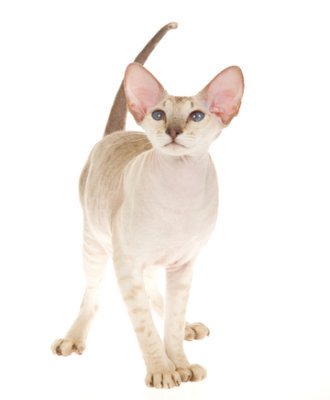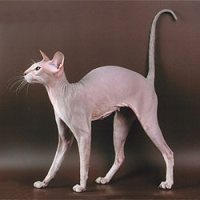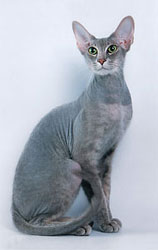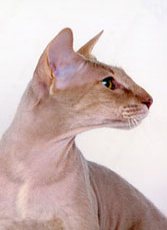The Peterbald Cat Breed
History
The Peterbald cat breed was the result of a cross-breeding between a Donskoy cat and an Oriental Shorthair cat.
In St. Petersburg in 1993, a brown mackerel tabby Donskoy was bred to a tortoiseshell Oriental female. Their offspring became very popular and became known as Peterbalds. Cross-breeding between Oriental Shorthairs, Siamese and Donskoy cats helped develop new lines.
 Peterbald Cat
Peterbald Cat
The Peterbald cat breed has the Donskoy’s balding gene and the elegant look of the Siamese and the Oriental Shorthair.
In 1997 the Peterbald was accepted into the new breed program and in 2005 TICA recognized it for championship status.
Description

The Peterbald cat breed is a graceful and elegant hairless cat breed. They have long bodies with long and dainty legs.
The tail is long and whippy and the neck is slender and graceful. The ears are extra large and set very low on the head.
The head is a long wedge shape that ends in blunt muzzle. The paws are oval shaped and have agile fingers and toes that the Peterbald uses to grasp objects.
The Peterbald cat breed’s coats are divided into two groups: Bald and Hairy. Bald is further divided into Ultra Bald, Flock or Chamois and Velour. Hairy is further divided into Brush and Straight.
Ultra Bald
Kittens are born without any hair and never grow any hair. The skin is warm and sticky to the touch. Ultra Bald Peterbald cats have no eyebrows or whiskers.
Flock or Chamois
Peterbalds in this category are 90% hairless with no visible hair and feel smooth to the touch. There is no coat resistance when you stroke this cat and no sticky feeling. There might be down hair on the extremities with the whiskers and eyebrows being kinked, curled and/or broken.
Velour
The Velour Peterbald is 70% hairless with a coat that can be up to 1mm in length. If the coat is sparse the skin is clearly visible, but if the coat is dense and shiny it gives the cat a sleek look. When the cat matures, its coat may become Flock or Chamois.

Brush
Peterbald cats with a brush coat have wiry hair that range from barely wavy to almost curly. The texture is irregular and the hair can be up to 5mm long. Kittens born with a brush coat may change to bald by the age of 2. Kittens born with a dense brush coat will always have a brush coat. The whiskers are curled or kinked.
Straight
The straight-coated Peterbald cat does not have the hair loss gene and will have a short coat that lies closely to the body with normal, straight whiskers.
The Peterbald cat breed needs extra special skin care. They need regular bathing to remove dirt and grease from their skins. Ultra Bald cats need a bath more often as their skins are a lot oilier.
Ensure that you clean the ears and the nail beds as dirt can build up in these areas. Use a sunblock or make sure that you limit sun exposure. In winter, provide a basket with warm bedding.
Personality & Temperament
The Peterbald cat breed is a highly intelligent and affectionate cat breed. Inquisitive and playful, they will investigate anything and “assist” you with any of your tasks.
This is a very active cat breed that does well playing on its own or involving you in a game of fetch. Ensure that you provide lots of different toys to stimulate and engage your cat.

They are extremely devoted to their humans and do not do well on their own. It is worth considering another Peterbald should you have to leave your cat on its own for long periods of time. Peterbalds get on well with other pets and children.
The lack of coat with a Peterbald does not guarantee that you will not be allergic. Spend some time with a Peterbald before getting one to see if they trigger any kind of allergic reaction.







